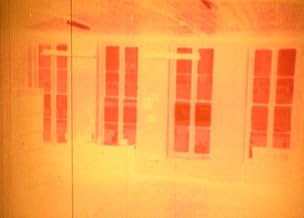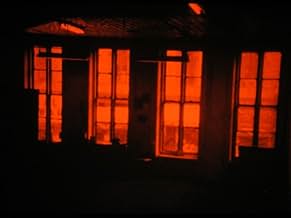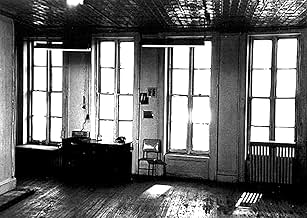Aggiungi una trama nella tua linguaClaimed by some to be one of the most unconventional and experimental films ever made, Wavelength is a structural film of a 45-minute long zoom in on a window over a period of a week. Very u... Leggi tuttoClaimed by some to be one of the most unconventional and experimental films ever made, Wavelength is a structural film of a 45-minute long zoom in on a window over a period of a week. Very unconventional and experimental, indeed.Claimed by some to be one of the most unconventional and experimental films ever made, Wavelength is a structural film of a 45-minute long zoom in on a window over a period of a week. Very unconventional and experimental, indeed.
- Regia
- Sceneggiatura
- Star
- Premi
- 1 vittoria in totale
Recensioni in evidenza
Like Hollis Frampton's ZORNS LEMMA, WAVELENGTH is the kind of picture made to be written about, not really endured. The glowing descriptions of it in critics' prose are more provoking than the actual artifact itself. Two things remain striking and puzzling about it thirty-two years later. Why did Snow choose to make a near-hour-long demonstration of the zoom lens? Why would tracking have been any different--is the movie meant to be a statement on a subjective appearance of changed perspective, while the viewer really remains static? Or was Snow just infatuated with the gimmickry of the zoom? (Each calibration churning closer to the photograph has a home-movie clunkiness.)
The other is the oddly hippie-dippie tone of Snow's inserted gimcrackery. From the charwoman-looking extra playing "Strawberry Fields Forever" on a radio, then lumbering off like a bit player in an Ed Wood number, to the acid-flashback reruns of just-passed scenes, to the freak colorizations of arbitrary moments (as if we jumped to the POV of a UFO), the ambience is much more Big Brother and the Holding Company than Robert Bresson. It's the same playing-with-a-gizmo amateurism that mars the images using people in Stan Brakhage's DOG STAR MAN, and it makes Snow's academic astringency look like a pose.
(WAVELENGTH showed up again, ripped off in the unlikeliest place: the track into a photograph that forms the "Twilight Zone" epilogue to Kubrick's THE SHINING.)
With Snow, there *is* a process, and it's something that could possibly make some of you sick. But first, here's what should be noted: this is not entirely an unbroken take. It is "unbroken" as far as the camera's set-up, since it isn't moving from its spot like on a dolly track and the zoom is moving at a pace a snail would go, 'catch up, man, Jesus!' But all cameras holding film need to change the reels, so every so often as Snow is zooming in on the inside of a room that has about four windows looking out over a city, with two chairs, and three pictures on the farthest wall, he does cut in with what could be called visual static. He also does some treatment to the image as far as super-imposed colors and strobes, or what may be the 1960s take on that, and then near the very end of the film (in the last two/three minutes) there is what one might call a dissolve. There may be more dissolves here, but I lost count by a certain point.
Wavelength is not frustrating to look at since every so often it'll throw in some people to look at - and sure, one of them, for no reason, drops dead (this is the experimental filmmaker Hollis Frampton making an appearance - I think, though I'm not sure, future film critic Amy Taubin shows up later on as the woman making a phone call telling someone that there's a dead man on the floor) - or even a song (the Beatles's 'Strawberry Fields Forever' is the one sliver of music to pipe in on a radio). But the audio of it is unique, and I'm not sure if it's in a way that is meant to make one curl up into a ball. It's borderline torture; think of when a tea kettle is ready and keeps on whistling - it's that, times a hundred. As the image in Snow's lens brings us inexorably, every so slowly but in that gradual way that you WILL focus on what he wants you to look at, the audio becomes ever so sharply loaded with noise. Compared to this, Lou Reed's Metal Machine Music is easy listening.
I had a different experience watching this than maybe some of you; it's available online so I hooked up my hd TV and watched it on a big screen as as I could, but I also could turn down the volume. If I saw this on 35mm in a theater with good light and good sound, I wonder if I would be more put off. But this isn't a knock against Snow exactly; I realized that the sound wasn't going to go down, so I decided to go with it. If this is the artist's process, to bring one into... well, what? I hasten to call it an 'avant-garde masterpiece', or some pretentious disaster, because I feel like/know I would need more of a critical justification. What is this TRYING to do, and does it accomplish it? Simply put: everyone who comes to this will get something out of it (for me, one part that I found compelling is how my mind might wander while looking at this shot zooming closer, and ten SNAP back into Snow's aesthetic when he messed with the image, adding color and more ferocious noise).
Maybe all you need to make a movie isn't a girl and a gun, but a single room with an interesting look and ideas that push the boundaries of what one expects to see in a motion picture. Snow may be saying, 'look at this room, look at what's going on, listen to it, and there may be things going on you didn't expect - look closer.' Or it could be a fantastical trip to do drugs to. This does move, but in such a way that creeps up on you as it creeps along. And ultimately it is... unique.
The forty-five minute long work is a single scene of a room, experimented with using various color filters, slowly and gradually zooming in to a photo on the wall of the room. Very little occurs onscreen except for the zoom, and in many ways it is really a series of film variations on the only focal point. That's not to say there is no onscreen action though; traffic can be seen occasionally moving outside the windows of the room, several women enter early on whilst a Beatles song is played, and the climax is a series of loud banging noises--as though a burglary is happening offscreen--before the great experimental filmmaker Hollis Frampton enters the shot and falls dead to the floor.
One other reviewer has interpreted that the film's goal is that to have almost nothing happen the viewer gets to appreciate more what does happen, and this is a very good point. In either case, it is a very interesting and abstract experimental work, as well as the ending which does a quite literal turn on the title, and an absolute must for fans of experimental cinema. It's boring only if you look at it as a scene of a room; it becomes interesting when you delight in the moments of action and I really liked it because it kept my interest despite the lack of events. I found that when watching it it was not a painfully boring watch like many say, because after a while you accept nothing big is going to happen and let the movie play out as it is. To be constantly bored at a movie for an entire forty-five minutes is quite unnatural, at least for me.
During the painfully slow zoom things happen in the room, though it's never busy or plot-driven. The highlight for me was when someone snapped on a radio and the Beatles "Strawberry Fields" played. Was that an underhanded way of saying that the film was a bad LSD trip?
Beyond the Beatles, the soundtrack consists of a long, annoying, screeching crescendo. It's awful, but try as I could, I was unable to catch a short nap during the film because of the soundtrack. For that it earns my praise. I mean, if Hollywood can't keep me awake with their drivel, then this film deserves some kind of award.
Lo sapevi?
- QuizMichael Snow has stated that his intent with the film was for it to be "a summation of my nervous system, religious inklings and aesthetic ideas."
- Citazioni
Woman in fur coat: I just got here, and there's a man lying on the floor, and I think he's dead.
- ConnessioniEdited into WVLNT: Wavelength For Those Who Don't Have The Time (2003)
I più visti
Dettagli
- Tempo di esecuzione45 minuti
- Colore
- Proporzioni
- 1.37 : 1
Contribuisci a questa pagina


















